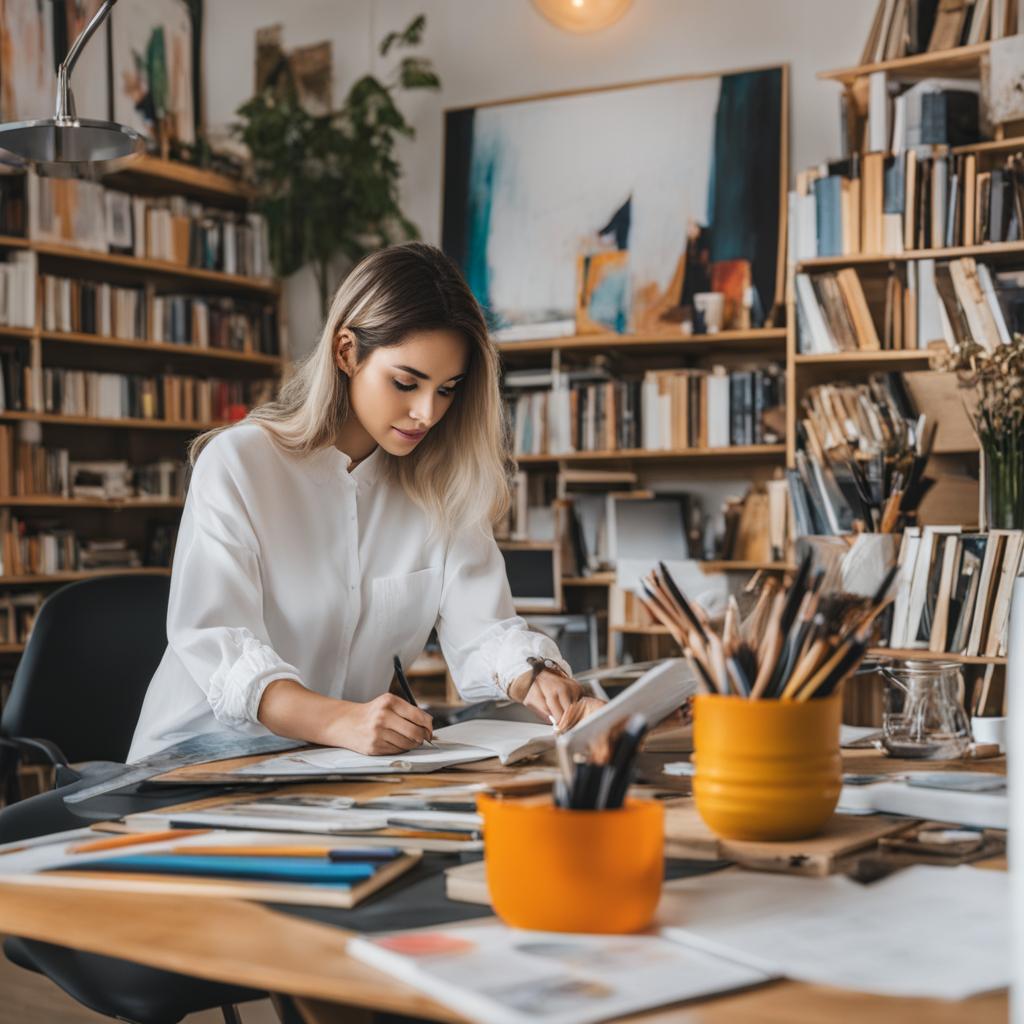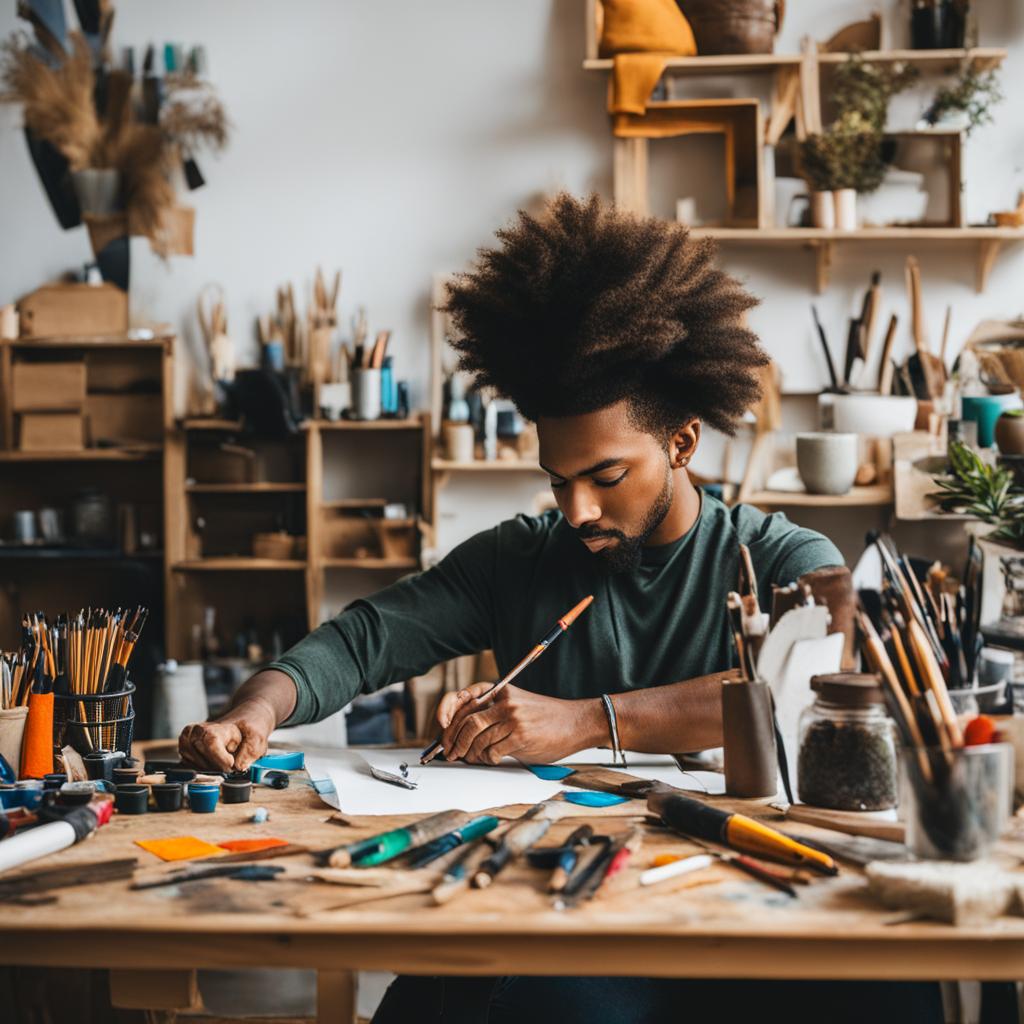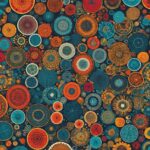Becoming a freelance artist is an exciting venture, offering the opportunity to pursue your passion while showcasing your creativity to the world. With the increasing demand for visual content in various industries, freelancing as an artist has become a viable career option. Whether you specialize in fine art, graphic design, illustration, or music, this guide will provide you with 10 steps to establish yourself as a successful freelance artist.
Key Takeaways:
- Freelancing as an artist allows you to showcase your creative skills and turn your passion into a rewarding career.
- Establishing a clear business model and determining your artistic niche is crucial for success as a freelance artist.
- Building a strong portfolio that highlights your best work and appeals to potential clients is essential.
- Creating a satisfying experience for clients by delivering quality work and maintaining good communication is key to building a solid reputation.
- To ensure a sustainable career, diversify your income streams and continuously develop your business skills.
Start with a Business Model
To succeed as a freelance artist, it is essential to understand and decide on a business model. This involves determining what type of art you offer, such as fine art, graphic design, illustration, or music. Having a clear plan from the beginning will help you focus your efforts and set yourself up for success.
“Your business model serves as the foundation for your freelance artist career. It defines the type of art you create and the target audience you cater to. By identifying your niche and specialization, you can position yourself strategically in the market and attract the right clients.”
Choosing the Right Business Model
When selecting a business model as a freelance artist, it’s important to consider your passions, skills, and market demand. Here are some popular business models to consider:
- Fine Art: If you enjoy creating original works of art, selling them directly to collectors, or exhibiting in galleries can be a viable business model. Focus on developing a signature style and building a personal brand to stand out in the competitive art market.
- Graphic Design: If you have a knack for visual communication and enjoy creating designs for branding, marketing, and advertising projects, the graphic design business model can be a lucrative option. Develop a strong portfolio showcasing your design skills across different mediums.
- Illustration: If you excel at storytelling through visual art, consider the illustration business model. This can involve creating illustrations for books, magazines, websites, or even animations. Develop a versatile portfolio that showcases your ability to bring ideas to life through visuals.
- Music: If you have musical talent, you can explore the business model of composing music, providing music lessons, or performing live. Collaborating with filmmakers, game developers, or advertising agencies can expand your opportunities as a freelance musician.
Benefits of Having a Business Model
Establishing a solid business model as a freelance artist offers several benefits:
- Clarity: Having a clear business model helps you define your artistic direction and target market, allowing you to focus your efforts and resources.
- Efficiency: A well-defined business model enables you to streamline your processes, pricing, and marketing strategies, leading to increased efficiency in running your freelance artist business.
- Positioning: By choosing a specific business model, you can position yourself as an expert in your chosen niche, attracting clients who are specifically seeking your type of art.
- Brand Building: A strong business model allows you to build a cohesive brand around your art, making it easier to market yourself and create a recognizable identity in the art community.
By starting your freelance artist journey with a well-defined business model, you can set yourself up for success and create a strong foundation for your artistic career.
Comparing Different Business Models for Freelance Artists
| Business Model | Key Focus | Target Audience | Income Potential |
|---|---|---|---|
| Fine Art | Creating original artwork | Collectors, galleries | High (dependent on demand) |
| Graphic Design | Visual communication and design | Branding, marketing, advertising | Medium to high (depending on client base) |
| Illustration | Visual storytelling | Book publishers, magazines, websites | Medium to high (based on demand) |
| Music | Composing, performing, teaching | Filmmakers, game developers, music students | Variable (depending on projects and clients) |
Find Your First Few Clients
Now that you’re ready to embark on your freelance artist journey, it’s time to find your first clients and start showcasing your talents. Building a client base can seem daunting at first, but with a strategic approach and a little persistence, you’ll be well on your way to success.
Tapping into Your Personal Network
One of the best places to start when searching for your first clients is within your personal network. Reach out to friends, family, and colleagues who may be interested in your artistic services or know someone who is. They can provide valuable connections and referrals that can jumpstart your freelance career. Remember, word of mouth can be a powerful tool.
“I found my first few clients by sharing my work with friends and family. They were excited to support me and spread the word about my art. Within no time, I had inquiries from people I had never met before!” – Olivia, Freelance Artist
Freelance Art Job Sites
Another avenue to explore is freelance art job sites. These websites cater specifically to artists and provide a platform for connecting with potential clients who are actively seeking artistic services. Take the time to create a compelling profile and browse through available opportunities.
“I discovered my first significant freelance project through an art job site. It offered the perfect opportunity to showcase my skills and gain exposure in the art community. This one project opened doors to many more exciting projects!” – Ethan, Freelance Artist
Here are a few popular freelance art job sites to get you started:
| Freelance Art Job Sites | Description |
|---|---|
| 1. Behance | A platform where artists can showcase their work and connect with clients from various industries. |
| 2. Dribbble | An online community for designers to share their portfolios and find freelance opportunities. |
| 3. Freelancer | A global freelancing platform offering a wide range of artistic projects. |
Pro Bono Work for Exposure
Consider doing pro bono work strategically to gain exposure and build your portfolio. Offer your artistic services to local charities, non-profit organizations, or small businesses that align with your artistic style and values. While unpaid, pro bono work can open doors to new connections, potential clients, and valuable experiences.
Remember, even if you’re not charging for your services initially, always treat pro bono projects with the same level of professionalism and commitment as paid ones. Quality work and satisfied clients can be the stepping stones to future paid opportunities.
As you grow your client base, it’s important to maintain a balance between paid projects and pro bono work. Gradually transition towards paid opportunities and adjust your rates as you gain experience and confidence.
By tapping into your personal network, exploring freelance art job sites, and strategically offering pro bono services, you’ll be well on your way to finding your first few clients as a freelance artist. Remember to showcase your unique style, provide exceptional service, and let your passion shine through your work.
Build a Basic (but Powerful) Portfolio
As a freelance artist, your portfolio is your calling card – it’s what captures the attention and interest of potential clients. A well-crafted portfolio showcases your artistic abilities, demonstrates your unique style, and sets you apart from other artists in the industry. When it comes to building your portfolio, simplicity and impact are key.
Start by creating a basic online portfolio that highlights your best work. Choose a clean and user-friendly design that allows your artwork to take center stage. Remember, clients are looking for artists who can meet their specific needs, so tailor your portfolio to showcase pieces that align with the type of work you want to attract. Including a variety of styles, mediums, and subject matters can demonstrate your versatility and artistic range.
Organize your portfolio in a logical and intuitive way. Consider categorizing your artwork by medium, theme, or client type. This helps clients navigate through your portfolio and find exactly what they’re looking for. Keep your portfolio concise by selecting a curated selection of your strongest pieces. Quality over quantity is important – it’s better to have a small selection of exceptional artwork than a large collection of mediocre pieces.
“A powerful portfolio is more than just a showcase of your artwork; it’s a representation of your artistic vision and professionalism.”
Engage Your Audience
Captivate potential clients right from the start with a captivating introduction. Use a short artist statement or bio to tell your unique story, highlighting your artistic journey, inspirations, and artistic philosophy. This personal touch makes your portfolio more relatable and allows clients to connect with you on a deeper level.
Don’t be afraid to include testimonials or client feedback in your portfolio. Positive reviews from satisfied clients can add credibility and build trust in your abilities as an artist. Consider showcasing your artwork in real-life settings or alongside client branding to help clients visualize how your work can enhance their projects.
Keep It Updated
A successful freelance artist is constantly evolving, experimenting, and creating new work. Regularly update your portfolio to reflect your latest projects and skills. Remove older or less relevant pieces to keep your portfolio fresh and focused. Remember to also update your contact information, social media links, and any other relevant details to ensure that potential clients can easily get in touch with you.
Elements of an Effective Online Portfolio
| Element | Description |
|---|---|
| High-quality Images | Clear, well-lit, and properly formatted images that accurately depict your artwork. |
| Artist Statement | A concise and compelling introduction that showcases your unique artistic style and vision. |
| Curated Selection | A thoughtfully chosen collection of your best and most relevant artwork. |
| Category Organization | Logical categorization of your artwork to help clients navigate through your portfolio. |
| Cohesive Design | A visually pleasing and user-friendly layout that complements your artwork. |
| Contact Information | Clear and easily accessible contact details for potential clients to reach out to you. |
Create, Create, Create
As a freelance artist, I understand that creating artwork is the heart and soul of my business. It’s where my passion lies, and it’s what sets me apart from others in the industry. Whether it’s painting, illustration, or graphic design, I immerse myself in the creative process to produce unique and compelling pieces of art.
Creating art goes beyond just fulfilling client projects. It’s about exploring new ideas, experimenting with different styles and techniques, and pushing the boundaries of my own creativity. The more I create, the more I learn and grow as an artist.
One of the best ways to showcase my skills and attract clients is by building up a diverse portfolio. By dedicating time to work on both paid projects and pro bono opportunities, I can demonstrate the range of my abilities and attract a wider audience. Each piece I create adds value to my portfolio and increases my chances of grabbing the attention of potential clients.
But it’s not just about quantity; quality matters too. I strive to create art that resonates with my clients’ needs and desires. By truly understanding their vision and incorporating my artistic flair, I can deliver artwork that exceeds their expectations. This not only ensures client satisfaction but also leads to positive word-of-mouth referrals, which can be a powerful tool in growing my freelance artist business.
Stay Inspired
Staying inspired and motivated is crucial for any artist. As a freelance artist, I find inspiration in a variety of sources: from nature and the world around me to other artists, both contemporary and historical. I make it a point to surround myself with art, visit galleries and exhibitions, and engage in creative communities both online and offline.
“Creativity is contagious. Pass it on.” – Albert Einstein
By immersing myself in the art world, I can draw inspiration from different styles, techniques, and perspectives. This allows me to continuously evolve as an artist and bring fresh ideas to my clients’ projects.
Exploring Different Mediums
Diversifying my skills and exploring different mediums is another aspect of creating art that I find incredibly rewarding. While I may have a primary focus, such as fine art or digital illustration, I enjoy experimenting with different mediums to expand my artistic horizons.
Trying my hand at various mediums, such as acrylics, watercolors, or even sculpting, allows me to discover new techniques and push the boundaries of my creativity. It also gives me the opportunity to offer a wider range of services to clients, catering to different preferences and needs.
Continuous Growth and Learning
As a freelance artist, I recognize the importance of continuous growth and learning. The art world is ever-evolving, and it’s essential to stay up to date with the latest trends and developments. I invest time in honing my skills, attending workshops, and even taking online courses to stay ahead of the curve.
By dedicating myself to constant growth and improvement, I ensure that my art remains relevant and compelling. Clients appreciate artists who continuously challenge themselves and push their artistic boundaries.
| Benefits of Creating Art Constantly |
|---|
| 1. Showcasing a diverse range of skills to attract clients |
| 2. Increasing the chances of word-of-mouth referrals |
| 3. Staying inspired and motivated as an artist |
| 4. Exploring different mediums to expand artistic horizons |
| 5. Continuing growth and learning to stay ahead in the art world |
In conclusion, as a freelance artist, creating art is not just a job—it’s my passion, my way of expressing myself, and my pathway to success. By dedicating time and energy to create art consistently, I can attract clients, cultivate my skills, and carve out a unique niche in the art industry.

Deliver a Highly Satisfying Experience
As a freelance artist, prioritizing client satisfaction is essential for the growth and success of your business. While maintaining your artistic integrity is important, it is equally crucial to accommodate client preferences and deliver on their expectations. By doing so, you can build a solid reputation and establish long-lasting relationships with your clients.
When working with clients, it is important to listen actively and communicate effectively. Take the time to understand their vision, requirements, and goals for the project. By doing so, you can ensure that your artwork aligns with their expectations and creates a positive impression.
One way to ensure client satisfaction is to provide regular updates on the progress of the project. This helps them feel involved in the creative process and gives them the opportunity to provide feedback or suggestions along the way. It also builds trust and transparency between you and your clients.
Another key aspect of delivering a satisfying experience is meeting deadlines. Time management is crucial in the freelance world, and by delivering your work on time or even ahead of schedule, you demonstrate professionalism and reliability. This helps build trust and confidence in your abilities as a freelance artist.
“I strive to exceed my client’s expectations by actively involving them in the creative process and delivering high-quality artwork on time. By doing so, I ensure their satisfaction and build long-term relationships.” – Rachel Thompson, Freelance Artist
Going the Extra Mile
To truly impress your clients and exceed their expectations, consider going the extra mile. This could involve offering additional services or perks that enhance their overall experience. For example, you could provide personalized packaging for physical artwork or offer discounts for returning clients. These small gestures can leave a lasting impression and make your clients feel valued and appreciated.
Furthermore, actively seeking client feedback is a valuable practice. By soliciting input after project completion, you can gain insights into areas of improvement and further tailor your services to meet their needs. This commitment to continuous improvement will set you apart from other freelance artists and ensure ongoing client satisfaction.
| Key Strategies for Client Satisfaction | Benefits |
|---|---|
| Listening actively and communicating effectively | Ensures that client expectations are met and creates a positive working relationship |
| Providing regular updates and involving clients in the creative process | Builds trust, transparency, and fosters collaboration |
| Delivering work on time or ahead of schedule | Demonstrates professionalism, reliability, and respect for the client’s time |
| Offering additional services or perks | Leaves a lasting positive impression and makes clients feel valued |
| Soliciting client feedback after project completion | Provides valuable insights for improvement and allows for tailored services |
In conclusion, client satisfaction is a fundamental aspect of building a successful freelance artist business. By prioritizing effective communication, meeting deadlines, and going the extra mile, you can ensure that your clients are delighted with your work, resulting in referrals and a sustainable flow of projects.
Don’t Get Too Selective Early On
As a freelance artist starting your career, it is important to resist the temptation of being overly selective with client projects. While it’s natural to have preferences and specific artistic visions, taking on a variety of projects in the early stages is crucial for building a solid foundation.
By working on diverse projects, you have the opportunity to explore different styles, mediums, and subject matters. This broadens your experience, allows you to discover what you truly enjoy, and helps you refine your skills. Plus, it opens doors to unexpected opportunities and collaborations that can enhance your portfolio and reputation.
“Every project, no matter how small or seemingly unrelated to your core artistic style, can teach you something valuable and contribute to your growth as an artist.”
When starting out, prioritize gaining practical experience and expanding your network. Embrace the chance to work with different clients and industries, as it exposes you to new perspectives and challenges. By establishing a strong foundation through varied projects, you set yourself up for long-term success.
Building a Diverse Portfolio
One of the key benefits of taking on a range of projects early on is the opportunity to build a diverse portfolio that showcases your versatility as an artist. As clients explore your work, they want to see your ability to adapt and excel in various contexts.
Here’s an example of how a diverse portfolio can look:
| Project Type | Description |
|---|---|
| Fine Art | An oil painting capturing the serene beauty of a landscape |
| Graphic Design | An engaging logo for a local business that evokes their unique brand identity |
| Illustration | A whimsical children’s book illustration depicting an imaginative world |
| Music | An original composition for a short film, setting the mood for the narrative |
Having a diverse portfolio not only showcases your skills but also demonstrates your adaptability and creativity. It allows potential clients to envision how your artistic talents can meet their specific needs.
Remember, being open to different types of projects in the early stages of your freelance artist career is an opportunity for growth and exploration. By embracing variety, you lay the groundwork for a successful and fulfilling artistic journey.

Find Another Round of Clients (and Keep Them!)
As a freelance artist, the continuous acquisition of clients is crucial for the sustainability of your business. To expand your client base, consider implementing effective marketing strategies. Here are some tips to attract new clients and retain their business:
- Social Media Promotion: Utilize popular social media platforms like Instagram, Facebook, and Pinterest to showcase your artwork. Regularly post your latest creations, engage with your audience, and use relevant hashtags to reach a wider audience.
- Networking: Attend art-related events, join artist communities, and collaborate with other artists. Networking helps you establish connections within the art industry and can lead to potential client referrals.
- Showcasing Your Work: Display your artwork in relevant online platforms such as art galleries, online portfolios, and marketplaces. Offline, consider participating in local art exhibitions or renting wall space in coffee shops or galleries.
- Maintaining Positive Relationships: Client retention is as important as client acquisition. Provide exceptional customer service, meet deadlines, and communicate effectively with your clients. Show appreciation for their support, and they’ll be more likely to recommend your services to others.
By implementing these strategies, you can attract new clients to your freelance art business while maintaining a loyal customer base.
“Networking is a powerful tool that can lead to exciting opportunities and valuable collaborations.”
Client Acquisition and Retention Strategies Comparison
| Strategies | Client Acquisition | Client Retention |
|---|---|---|
| Social Media Promotion | ✓ | ✓ |
| Networking | ✓ | ✓ |
| Showcasing Your Work | ✓ | ✓ |
| Maintaining Positive Relationships | ✓ |
Diversify Your Income Streams
As a freelance artist, it’s essential to think beyond relying solely on client projects to secure your financial stability. Diversifying your income streams is a smart strategy to mitigate risks and ensure a steady flow of revenue. Here are some effective ways to diversify your income as a freelance artist:
Sell Prints of Your Artwork
Take advantage of your unique artistic style and create prints that can be sold to art enthusiasts and collectors. By offering prints of your artwork, you can generate passive income and reach a wider audience. Set up an online store or partner with art galleries to showcase and sell your prints.
Offer Online Courses or Workshops
Share your expertise with aspiring artists by creating and offering online courses or workshops. This allows you to monetize your knowledge and skills while providing value to others. Consider platforms like Udemy or Teachable to host your courses and reach a global audience.
Explore Licensing Opportunities
License your artwork to be used in various products such as posters, home decor, or merchandise. Collaborate with brands or licensing agencies to leverage your artistic creations and earn royalties. This can be a lucrative source of passive income, especially if your artwork resonates with a wide audience.
Participate in Art Exhibitions and Events
Engage with your local art community by participating in art exhibitions, fairs, or events. This not only gives you the opportunity to showcase and sell your artwork but also network with potential clients and collaborators. Stay updated with local art organizations and venues to ensure you’re aware of upcoming opportunities.
Create an Art-related Blog or Podcast
Share your insights, experiences, and knowledge about the art industry by creating a blog or podcast. This allows you to attract a dedicated audience and earn additional income through sponsorships, affiliate marketing, or donations. Build your online presence and establish yourself as an authority in your niche.
Collaborate with Other Artists
Collaboration with other artists can open up new possibilities for income generation. Consider partnering with fellow artists on joint projects, exhibitions, or even creative workshops. By pooling your talents and resources, you can reach a wider audience and expand your earning potential.
Provide Art-related Services
Offer additional services related to your artistic skills, such as custom illustrations, art consulting, or mural painting. These services can cater to both individuals and businesses, providing you with diverse income streams and opportunities to showcase your expertise.
By diversifying your income as a freelance artist, you can not only ensure financial stability but also expand your artistic reach and explore new creative avenues. Embrace these opportunities to grow as an artist and create a thriving and sustainable career.

Master the Skills it Takes to Run a Business
To thrive as a freelance artist, it’s important to develop a range of essential business skills. These skills will equip you to effectively manage projects, communicate with clients, and handle the financial aspects of your business. Continuously honing these skills is key to ensuring the long-term success of your freelance artist career.
Project Management
An integral skill for any freelance artist is project management. Being able to effectively plan, organize, and execute your projects will not only ensure timely delivery but also help you maintain a positive reputation with clients. By setting clear goals and timelines, arranging your resources efficiently, and managing potential obstacles, you can ensure a smooth workflow and deliver high-quality work.
Client Communication
Communication is a vital aspect of running a successful freelance artist business. Building strong relationships with your clients requires effective and professional communication. This includes active listening, understanding client needs, and providing regular updates on project progress. Clear and open communication will foster trust, enhance client satisfaction, and increase the likelihood of repeat business and referrals.
Financial Management
As a freelance artist, understanding and managing finances is crucial for the sustainability of your business. Track your income and expenses, create a budget, and set pricing strategies that reflect the value of your work. Additionally, consider investing in accounting software or hiring a professional to help you manage your finances effectively. Taking proactive steps to ensure financial stability will enable you to focus on your artistic endeavors with peace of mind.
By mastering these key business skills, you will be well-equipped to navigate the challenges of running a successful freelance artist career. Remember, talent alone is not enough; developing these skills will help you establish yourself as a professional and build a thriving business.
| Skill | Description |
|---|---|
| Project Management | Effectively plan, organize, and execute projects to ensure timely delivery. |
| Client Communication | Build strong relationships with clients through effective and professional communication. |
| Financial Management | Track income and expenses, create budgets, and set pricing strategies to ensure financial stability. |
You’ve Got This, Freelance Artists!
As a freelance artist, you have the incredible freedom to pursue your passion and create art on your own terms. It’s an opportunity to embrace your unique creativity and build a fulfilling career doing what you love. While the journey may have its challenges, with dedication, hard work, and a strategic approach, you can succeed as a freelance artist.
Believe in yourself and your abilities. Remember why you chose this path in the first place. Use that passion as fuel to push through any obstacles that may come your way. Trust your artistic instincts and have confidence in your skills. Your art is valuable, and there are people out there who will appreciate and support your work.
But success as a freelance artist is not just about talent. It’s about developing a solid business mindset. Treat your art as a business and learn the necessary skills to thrive in the industry. Stay organized, manage your projects effectively, and communicate professionally with clients. Continuously seek opportunities to improve your knowledge and skills, so you can deliver exceptional results and exceed client expectations.
Embrace the opportunities available in the art world. Seek out collaborations with other artists, participate in exhibitions and art festivals, and explore different mediums and styles. Stay open to learning and experimenting, as it will enhance your growth as an artist and expand your artistic horizons.
“The artist is nothing without the gift, but the gift is nothing without work.” – Emile Zola
Remember, building a successful freelance artist career takes time and persistence. Don’t get discouraged by setbacks or slow progress. Keep pushing forward, remain committed to your goals, and stay consistent in your efforts. Surround yourself with a supportive community of fellow artists who can provide encouragement, feedback, and inspiration.
And finally, always celebrate your achievements, no matter how small. Each step forward is a milestone and an indicator of your growth as an artist. Embrace the journey, enjoy the process, and keep creating. You have what it takes to thrive as a freelance artist.

| Key Takeaways | Actions to Take |
|---|---|
| Believe in your artistic abilities and trust your instincts. | Set aside time each day to create art and nurture your creativity. |
| Develop a business mindset and acquire the necessary skills to run a successful freelance artist business. | Invest in education and training relevant to your art and business. |
| Embrace opportunities to network, collaborate, and showcase your art. | Attend art events, join artist communities, and explore different mediums and styles. |
| Stay persistent, celebrate your achievements, and seek support from fellow artists. | Set clear goals, track your progress, and surround yourself with a supportive artistic community. |
Serious About Making Extra Money?
Freelancing as an artist can not only be a fulfilling career but also provide a source of extra income. Whether you’re looking to make some additional money on the side or turn your art into a full-time business, following the steps outlined in this article will set you on the path to success.
“Creativity is allowing yourself to make mistakes. Art is knowing which ones to keep.” – Scott Adams
Unlocking Your Potential as a Freelance Artist
As a freelance artist, you have the opportunity to explore your creativity while earning extra income. By leveraging your artistic skills and putting in the hard work, you can turn your passion for art into a profitable side hustle or even a full-time business.
Creating artwork allows you to express yourself and connect with others who appreciate your unique vision. And in today’s digital world, there are numerous platforms and online marketplaces that make it easier than ever to showcase and sell your art directly to buyers.
Whether you’re an aspiring artist looking to dip your toes into the world of freelancing or an experienced creative seeking to expand your client base, the tips and techniques shared in this article will guide you towards success.
Expanding Your Income Streams
One of the advantages of freelancing as an artist is the ability to diversify your income streams. While client projects may be your primary source of income, there are other avenues to explore to supplement your earnings and provide financial stability.
Consider the following opportunities to expand your income as a freelance artist:
- Create and sell prints of your artwork both online and at art fairs.
- Offer art workshops or classes to share your skills and knowledge with others.
- Collaborate with brands or businesses to create commissioned artwork or designs.
- Explore licensing opportunities to have your art featured on products or as digital assets.
- Participate in art competitions or exhibitions to gain exposure and recognition.
By diversifying your income streams, you not only increase your earning potential but also reduce the reliance on client projects alone. This can provide a buffer during lean periods and allow you to focus on creating art that truly inspires you.
Investing in Your Growth
Continual growth and development are essential for any freelance artist looking to thrive in a competitive industry. Take the time to invest in your skills and knowledge to stay relevant and attract new clients.
Consider the following avenues for personal and professional growth:
- Attend art workshops or conferences to learn from industry experts and expand your creative techniques.
- Join local art organizations or online communities to connect with fellow artists and gain valuable insights.
- Explore new mediums or techniques to broaden your artistic repertoire and attract a wider range of clients.
- Stay updated on industry trends and market demands to position yourself as a sought-after artist.
- Seek feedback and constructive criticism to continually improve your craft and grow as an artist.
By investing in your growth as an artist, you not only enhance your artistic capabilities but also increase your marketability and appeal to potential clients.
Conclusion
Becoming a freelance artist is a viable career option that allows you to pursue your passion while working on your own terms. By following the steps outlined in this article, you can successfully navigate the art world and build a thriving freelance artist business.
Embracing the opportunities available to you is essential. Tap into your personal network, explore freelance art job sites, and consider doing pro bono work to gain exposure. By finding your first few clients, you can kickstart your freelance artist career and start building your portfolio.
Remember to continuously develop your skills and deliver a highly satisfying experience to your clients. By maintaining client satisfaction and building positive relationships, you increase your chances of receiving word-of-mouth referrals and creating a sustainable flow of work. Additionally, don’t be too selective early on and explore a variety of projects to build a strong foundation.
As a freelance artist, diversifying your income streams is crucial for financial stability. Alongside client work, explore avenues such as selling prints of your artwork or offering online courses. This will help mitigate the risks associated with relying solely on client projects.
With the right approach, mindset, and continuous learning, you have what it takes to thrive as a freelance artist. Embrace the freedom and possibilities that come with this career, and believe in your ability to succeed. The art world is yours to conquer.
FAQ
Is becoming a freelance artist a feasible career option?
Yes, becoming a freelance artist is a viable career option with the growing demand for visual content both online and offline. Many artists are successfully earning a living through freelance art commissions and other art services.
How do I start as a freelance artist?
To start as a freelance artist, it is essential to determine your business model and specialize in a specific type of art, such as fine art, graphic design, illustration, or music. This will help you focus your efforts and set yourself up for success.
How do I find my first clients as a freelance artist?
To find your first clients, tap into your personal network by reaching out to friends, family, and colleagues. You can also explore freelance art job sites for potential opportunities or consider doing strategic pro bono work to gain exposure and build your portfolio.
How important is having a portfolio as a freelance artist?
Having a strong portfolio is crucial for attracting clients as a freelance artist. Start with a simple online portfolio that showcases your best work and demonstrates your artistic range. Keeping it concise and client-focused will increase your chances of converting potential clients.
How much should I create as a freelance artist?
As a freelance artist, it’s important to dedicate time to work on projects for clients and pro bono opportunities to build up your portfolio. The more you create, the more opportunities you have to attract clients and receive word-of-mouth referrals.
How do I ensure client satisfaction as a freelance artist?
Client satisfaction is key to growing your freelance artist business. While it’s important to maintain your artistic integrity, accommodating client preferences and delivering on their expectations will help build a solid reputation. Satisfied clients are more likely to refer you to others, leading to a sustainable flow of work.
Should I be selective with client projects as a freelance artist?
In the early stages of your freelance artist career, it’s important not to be too selective with client projects. By taking on a variety of projects, you can learn what you enjoy and build a strong foundation. Over time, you can start being more selective and focus on the types of projects that align with your artistic vision.
How can I find more clients and retain them as a freelance artist?
Continuous client acquisition is essential for the sustainability of your freelance artist business. Use various marketing strategies such as social media promotion, networking, and showcasing your work in relevant online and offline platforms. Additionally, prioritize maintaining positive relationships with existing clients to encourage repeat business.
How can I diversify my income as a freelance artist?
To secure your financial stability as a freelance artist, consider selling prints of your artwork, offering online courses or workshops, and exploring other avenues to generate passive income. This will provide stability and mitigate the risks associated with relying solely on client projects.
What skills do I need to succeed as a freelance artist?
To thrive as a freelance artist, you need to develop business skills such as project management, client communication, and financial management. Continuously learning and honing these skills will enable you to effectively run your business, handle client relationships, and ensure the success of your freelance artist career.
Is freelancing as an artist a fulfilling career?
Freelancing as an artist can not only be a fulfilling career but also provide a source of extra income. Whether you’re looking to make some additional money on the side or turn your art into a full-time business, following the steps outlined in this article will set you on the path to success.
Is it really possible to become a successful freelance artist?
Yes, becoming a freelance artist is a viable career option with the right approach and mindset. By following the steps outlined in this article, you can navigate the art world on your own terms and build a successful freelance artist business. Embrace the opportunities available, continuously develop your skills, and remember that you have what it takes to thrive as a freelance artist.
Can freelancing as an artist provide a stable income?
Freelancing as an artist can provide a stable income, especially if you diversify your income streams and explore other avenues such as selling prints of your artwork or offering online courses. By adopting a strategic approach and continuously attracting new clients, you can create a sustainable freelance artist career.
Our Friends
- https://www.sidehustlenation.com/freelance-artist/
- https://millennialmoneyman.com/freelance-artist/
- https://www.wix.com/blog/freelance-artist
Money posts:
 Masterworks Review | Easily Invest in Fine Art
Masterworks Review | Easily Invest in Fine Art
 How to Become a Freelance Web Developer (2024)
How to Become a Freelance Web Developer (2024)
 Become a Freelance Copywriter in the United States | A Guide (2024)
Become a Freelance Copywriter in the United States | A Guide (2024)
 13 Best Transcription Jobs for Beginners & Pros (2024)
13 Best Transcription Jobs for Beginners & Pros (2024)
 25 Best Business Ideas for Women to Start in 2024
25 Best Business Ideas for Women to Start in 2024
 15 Best Self-Employed Jobs You Can Start (2024)
15 Best Self-Employed Jobs You Can Start (2024)
 What is Freelancing? Complete Guide (2024)
What is Freelancing? Complete Guide (2024)
 The 19 Best Freelance Websites in (2024)
The 19 Best Freelance Websites in (2024)

